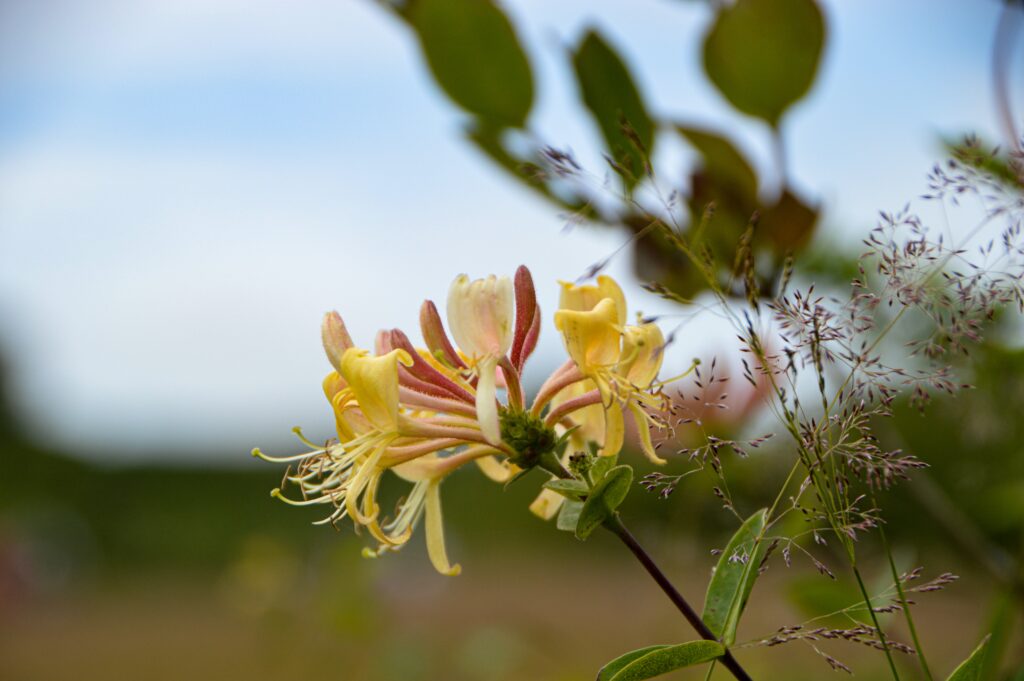
My neighbour is an avid gardener. I envy his green thumb. All spring and summer long, his garden is filled with flowering bushes and perennials. It looks like a paradise compared to mine.
Along the fence between our two properties, and supported by a trellis, there grows a honeysuckle vine. I love to watch its delicate pink and yellow blooms in the summertime as they wave in the wind, surrounded by the lush green leaves. It makes me feel all soft and warm and relaxed inside, like I’m living in Italy, or somewhere else along the Mediterranean and couldn’t be luckier.
The thing that astounds me about those delicate pink flowers is just how tiny they are. We used to sell pounds and pounds of honeysuckle flowers in our store, and it blows my mind how many bushes must have been needed in order to produce a single pound of this strong anti-viral herb. The acreage of honeysuckle fields in China must be enormous.
Since the advent of COVID 19, honeysuckle flowers have been hard to source because they are considered among the most potent of anti-viral herbs, and are the chief ingredient in many Chinese medicinal formulas for colds, flus and viral infections. Production has had difficulty keeping up with the immense demand. It’s no wonder that the price per pound has skyrocketed.
Why are honeysuckle flowers so popular and valued? Well, they are used for both the prevention and treatment of all sorts of infections. Scientific studies of honeysuckle flowers have found them to have broad spectrum inhibitory actions against staphylococcus aureus, B-hemolytic streptococcus, E. coli, bacillus dysenteriae, Vibrio cholerae, Salmonella typhi, Diplococcus pneumoniae, Diplococcus meningitidis, Pseudomonas aeruginosa, and Mycobacterium tuberculosis [1,2].
In addition to their potent anti-viral [3] and anti-bacterial ability, honeysuckle flowers also have marked anti-inflammatory and anti-pyretic properties, which means they bring down fever and help to combat inflammation everywhere in the body [4]. They are particularly effective for heat and inflammation in the upper chest and lung area [5], helping to soothe sore throat and thirst, as well as heat stroke, irritability, and insomnia.
In addition to that, they are also known to be particularly effective for all sorts of skin issues, including lung abscesses, skin sores, lesions, ulcerations, warts, and furuncles, and can be used both internally and externally for those problems.
It’s because of these potent anti-viral, anti-bacterial, anti-pyretic, anti-inflammatory, and skin soothing properties that honeysuckle flowers are featured in a number of our products. They are a prime ingredient in our Chrysanthemum tincture, as well as in our Prime Herbal Mouthwash and our Mu Shang herbal deodorant.
In doing research for this blog post, I’ve also discovered that honeysuckle flowers have been shown to benefit digestion! Studies show that honeysuckle flowers decrease the absorption of cholesterol in the gastrointestinal tract of rats, thus lowering cholesterol levels.[6] They also increase the excretion of bile acid and gastric acid, thus improving motility in the stomach and intestines.[7] They’re pretty amazing flowers!
I often think of honeysuckle flowers as being like echinacea root in Western herbalism. It’s often the first herb TCM practitioners reach for whenever they have an infection, or feel an onset of viral symptoms. I miss the days when honeysuckle flowers were cheaper and more readily available. Hopefully, once COVID 19 infections start to recede worldwide, we’ll have an easier time finding this delicate, beautiful, yet powerful herb.
- Xin Yi Xue (New Medicine), 1975; 6(3):155
- Jiang Xi Xin Yi Yao (Jiangxi New Medicine and Herbology); 1960;(1):34
- Guang Dong Zhong Yi (Guangdong Chinese Medicine), 1962; 5:25
- Shan Xi Yi Kan (Shangxi Journal of Medicine), 1960;(10):22
- Shang Hai Zhong Yi Yao Za Zhi (Shanghai Journal of Chinese Medicine and Herbology), 1983; 9:27
- Ke Xue Chu Ban She (Scientific Press), 1963:387
- Jiang Xi Xin Yi Yao (Jiangxi New Medicine and Herbology); 1960;(1):34
About the Author: Rebecca Wong has a BA in English Literature from the University of Waterloo and has been working in the herbal business since 2000. She studied at the Ontario College of Traditional Chinese Medicine under respected authorities Paul Des Rosiers and Vu Le, and graduated from the East West School of Planetary Herbology under Michael Tierra. She received training as a yoga teacher at The Branches in Kitchener/Waterloo, and therapeutic yoga teacher training from the School for Somatic Soulwork under Deniz Aydoslu. She now teaches yoga for anxiety, depression and burnout at Rebecca's Restful Yoga Studio in Toronto.
